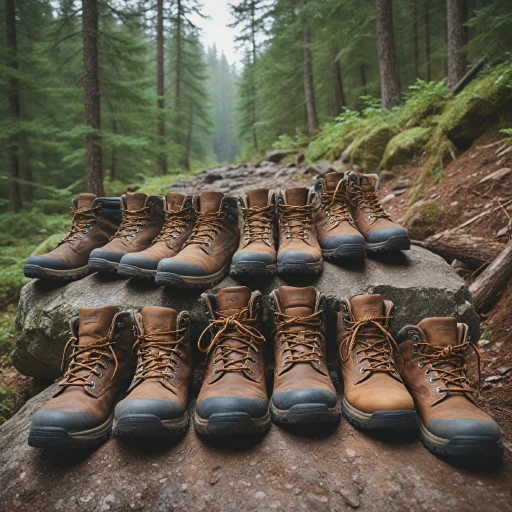
Understanding the Importance of Proper Hiking Boots
The Importance of Quality Hiking Footwear
When it comes to gearing up for a hike, especially for women, the focus shouldn't just be on pants, jackets, or quick-drying shirts. The foundation of any successful hiking experience lies in choosing the right hiking boots. Wearing proper hiking boots can be the difference between an enjoyable day on the trail and one filled with discomfort.
First and foremost, hiking boots provide the necessary support and protection that ordinary shoes cannot. They are designed to handle the diverse challenges of outdoor trails, from uneven terrain to weather changes. A good pair of hiking boots not only supports the feet and ankles but also helps distribute weight evenly, reducing strain on the body during long hikes.
Beyond comfort, consider the importance of durability and protection which proper hiking boots provide. Whether you're tackling a quick morning hike or gearing up for a multi-day trek, quality materials like leather and synthetic combinations can offer water-resistant features, essential for unpredictable outdoor conditions. Moreover, boots integrated with technologies such as moisture-wicking ensure your feet stay dry, minimizing the risk of blisters and discomfort.
For women hikers, investing in appropriately fitted boots is crucial. Ill-fitting boots can lead to a multitude of issues, from painful blisters to long-term injury risks. It’s important to remember that the right fit often depends on the activities you plan to undertake, the length of the trail, and the climate conditions.
In essence, whether you're going for a short trail near the city or a challenging mountain adventure, prioritizing the right hiking boots is a vital step in ensuring a great outdoor experience. They'll not only enhance your performance but also complement your overall hiking attire, from hiking pants to lightweight jackets that protect you from the sun.
Key Features to Look for in Hiking Boots
Essential Aspects for Choosing the Best Pair
When setting out to select the perfect hiking boots, it’s essential to consider certain features that cater to your unique hiking needs and conditions. Whether you're traversing a rocky trail or enjoying a leisurely walk, the proper shoe plays a massive role in your outdoor success. Here’s a rundown of key features to keep in mind:- Comfort and Fit: Proper fit prevents blisters and discomfort on long hikes. When trying on hiking boots, ensure they snugly wrap around your foot, leaving enough room at the toes.
- Support and Stability: High-cut models provide ankle support, which is invaluable on uneven terrain. This feature is especially beneficial for those hiking long distances or carrying heavier loads, often combining hiking pants and hiking shorts adaptations.
- Water Resistance: Many manufacturers offer water-resistant or waterproof options to keep your feet dry. For those hiking in more humid climates or damp conditions where https://www.hiking-boots.net/blog/the-ultimate-guide-to-wearing-shorts-while-hiking could be leveraged, this feature is crucial.
- Weight: Lightweight options are ideal for quick, short adventures or casual hikes. Consider how your base layer beneath a long sleeve or short sleeve shirt impacts the warmth and breathability offered by the boots.
- Durability: Evaluate the materials. Boots crafted from high-quality leather or synthetics provide better longevity. Check customer ratings and reviews, particularly the best-rated brands, for insights into durability.
Recognizing these key features can significantly influence your decision in choosing the right hiking footwear, whether pairing them with an outdoor jacket for additional sun protection, or with quick dry clothing under a hot sun.
Comparing Hiking Boots for Different Skill Levels
Level-Specific Insights for Choosing Hiking Boots
Understanding the differences between hiking boots for beginners, intermediate hikers, and seasoned mountaineers can help you make an informed purchase. Each level of experience comes with its own requirements, ensuring comfort and performance on the trails.
- Beginners: For those just starting, the priority is comfort and ease of wear. Look for lightweight boots with excellent cushioning and a flexible sole. These features can help you get accustomed to hiking without causing strain. When choosing apparel, opt for quick-dry shorts or pants paired with a breathable shirt, whether long or short sleeve, to keep cool and covered.
- Intermediate Hikers: As you gain experience, you might be tackling longer trails or more varied terrains. Boots with better ankle support and enhanced durability, possibly incorporating waterproof or water-resistant materials, are essential. Don’t forget moisture-wicking clothing, such as merino wool hiking socks or a base layer that provides sun protection, ensuring you're prepared for any weather changes on the path.
- Advanced Mountaineers: For those who have made hiking a serious activity, investing in high-quality boots with reinforced construction is advisable. These boots should have features like durable leather combined with modern synthetic materials for an exceptional balance of toughness and breathability. Your outfit should involve high performance outdoor clothing from reputable brands like North Face or Mountain Hardwear, known for their customer ratings in extreme conditions.
Consider your personal hiking environment: Are you often on wet trails? Then prioritizing those best suited for wet conditions might be beneficial. You can learn more by choosing the right hiking footwear for wet conditions, ensuring the best purchase for your needs.
Material Matters: Leather vs. Synthetic Hiking Boots
Deciphering Leather and Synthetic Hiking Boots
In the realm of hiking boots, the choice between leather and synthetic materials can significantly impact your outdoor experience. Both options offer unique benefits tailored to various hiking conditions, skill levels, and personal preferences. Leather hiking boots are lauded for their durability and classic appeal. They offer substantial support and protection, suitable for long treks and challenging trails. Leather is also water resistant, which is crucial for maintaining dry feet in wet conditions. When considering purchasing leather boots, pay attention to the customer rating and ensure they provide the foot support you need. On the other hand, synthetic hiking boots are celebrated for their lightweight nature and quick drying properties. These materials often feature moisture wicking capabilities, which help in keeping feet dry during long hikes. Synthetic boots are usually more breathable and often come with a reduced price tag compared to their leather counterparts, making them an attractive option for budget-conscious hikers. When deciding between leather and synthetic, consider the type of terrain and environment you'll be exploring. For women who frequently hike in wet or humid conditions, an option with quick drying and moisture wicking features would be ideal. Similarly, those venturing on rocky terrains might favor the robust protection of leather. To complement your choice of boots, remember that proper hiking attire, including moisture wicking shirts, women hiking pants, and a reliable hiking jacket, can greatly enhance your comfort on the trail. Whether you opt for long sleeve or short sleeve shirts, ensure they offer sun protection and support the overall performance of your hiking clothes ensemble.Breaking in Your Hiking Boots: Tips and Tricks
Preparing Your Boots for the Trail
Before you hit the trail in your new hiking boots, it’s essential to break them in. Properly broken-in boots can mean the difference between an enjoyable hike and one marred by discomfort. This process involves gradually getting your feet accustomed to the boots to prevent blisters and other issues.
Start Indoors
Begin by wearing your new boots around your home. Pair them with the socks you plan to wear while hiking, like merino wool hiking socks known for their moisture wicking and quick drying properties. Wearing your boots inside allows your feet to adjust to their shape and rigidity in a controlled environment.
Take Short Walks
Once your feet feel comfortable indoors, progress to short, outdoor walks. Wear your typical hiking attire—quick dry shorts, long sleeve shirts, or a lightweight jacket for sun protection—to mimic hiking conditions. These shorter walks help build your confidence in your new boots while allowing the shoes to mold to the shape of your feet gradually.
Gradually Increase Distance
As your boots become more comfortable, extend the length and intensity of your hikes. Choose trails with similar conditions to your planned hikes, considering variables like terrain and weather. Wearing a base layer on cooler days or hiking pants made from water-resistant materials can also help you prepare for different environmental factors. This step is crucial in ensuring that your boots are ready for longer hikes with diverse terrain.
Listen to Your Feet
Always be attentive to how your feet feel during this process. Any discomfort, especially blisters or pressure points, should be addressed immediately. Adjusting your laces, changing hiking socks, or adding insoles can make a significant difference. Opt for a shirt with a customizable fit to ensure no discomfort comes from ill-fitted sleeves or seams.
Maintaining Your Hiking Boots for Longevity
Extend the Life of Your Trail Companions
Proper care is essential to extending the lifespan of your hiking boots. For outdoor enthusiasts, experienced hikers, and mountaineers, this means implementing a few key maintenance practices. These practices ensure that your investment in the best hiking boots, regardless of whether they are made for women or designed for more general use, remains sound.- Clean After Each Hike: After hitting the trails, dirt and moisture can seep into the material, especially in quick drying synthetic options. Clean off mud and debris using a soft brush and water. For long lifespan, avoid using harsh chemicals as they can damage the waterproof coatings and affect moisture wicking properties.
- Dry Properly: Quick dry techniques can save your boots. Loosen the laces, remove the insoles, and allow the boots to air dry in a ventilated area. Avoid direct heat sources which can crack materials and reduce durability.
- Condition the Leather: For those who opt for leather over synthetic, conditioning is crucial. Applying a leather conditioner will keep the material supple and aid in maintaining water resistance. However, remember that over-conditioning can make the leather too soft.
- Inspect Regularly: Before donning your women-specific or general hiking boots for a trail run, inspect them. Check for any signs of wear or damage, such as worn soles or frayed laces. Address these issues promptly to maintain safety and performance.
- Store with Care: Store your hiking boots in a dry, cool place away from direct sunlight to prevent material degradation and preserve their best condition. Stuff them with newspaper or specialty boot trees to help them maintain their shape during the off-season.














